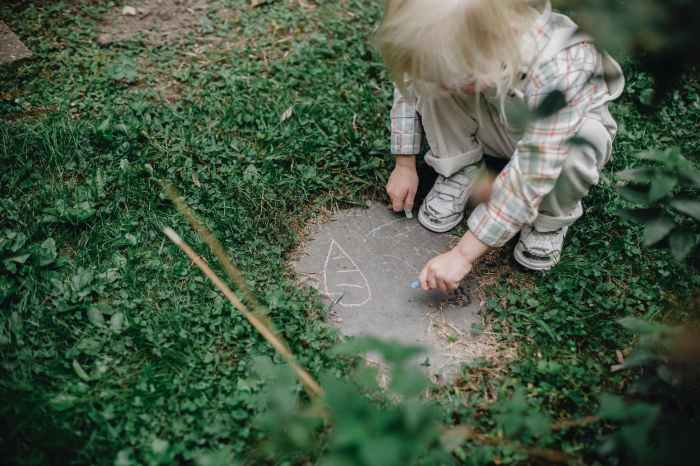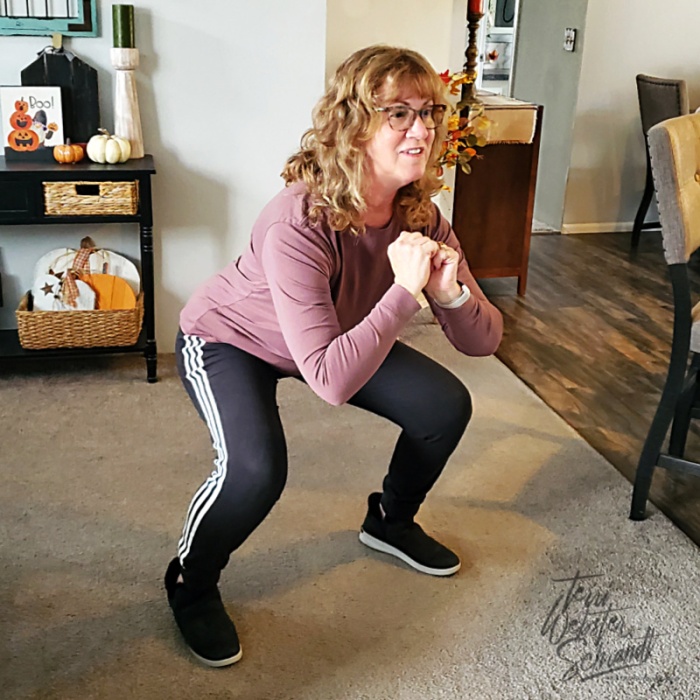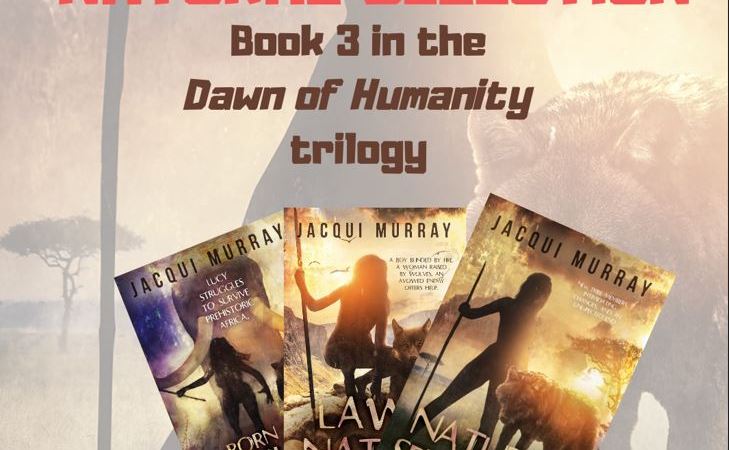I am excited to share Jacqui Murray’s latest release, Natural Selection, with you today. This is the third book in her series in which Lucy’s story culminates.

When you sit down to read a book, how do you sit? In a chair, perhaps cross-legged on a bed? Lounging on a chaise? I’m sure when you prepare to read Jacqui Murray’s new release Natural Selection, you will find a place that is comfortable for you. And that you should, because you might not be able to put down this latest book from her Dawn of Humanity series.
If you are a reader of Murray’s prehistoric fiction sagas, you know she spends countless hours researching every aspect of ancient humans: from their culture, their migrations, their languages—spoken or otherwise, to their physical appearance.
First, Let’s Get Physical
In this article, Murray shares her thoughts on the physiology of ancient man.
Why Squat? Why not Sit?
An online description of the squat: To crouch or sit with one’s knees bent and one’s heels close to or touching one’s buttocks or the back of one’s thighs. We see below how children naturally squat at play.

If you see pictures of earliest man, you may have noticed he didn’t sit cross-legged as we might, nor did he often seek out a log or tree stump to use as a chair. He squatted rather than sat. This we know from nominal physical evidence like telltale divots and scratches in the femur, tibia, and ankle bone of Neanderthals, most likely the result of squatting a lot. Neanderthals are a more recent Homo species than Lucy’s kind (the star of Natural Selection), but I make the assumption if Neanderthals didn’t sit, neither did earlier Homo species, such as Homo habilis and Homo erectus.
This shouldn’t surprise us. At least a fourth of mankind habitually crouches in a deep squat both at rest and at work. Squatting is far more natural for the body. It doesn’t require anything extra to make it happen–like a chair or bench. We simply stop walking, bend our knees, and rest. It is also much quicker to get out of should danger strike and a swift departure be required.
Chairs arrived less than 6,000 years ago. They probably were for royalty and rulers, something the wealthy could afford and commoners couldn’t. Physiologically, sitting in chairs is not a healthy position. The muscles around our spine are designed to squat which is why at least a fourth of mankind still habitually takes a load off its feet by crouching.

Who knew Lucy would be a healthy trendsetter?
Speaking of setting trends, can you perform a squat?

My 60+-year-old body does NOT like doing them but the exercise is super effective for lower body strength as every muscle is used. And NO, I cannot squat all the way down as shown in the earlier images. My knees are shot and I likely would have been left behind in Lucy’s tribe because a predator would have ended my life.
Makes you want to get out there and try some, huh?
Summary of Natural Selection

In this conclusion to Lucy’s journey, she and her tribe leave their good home to rescue former-tribe members captured by the enemy. Lucy’s tribe includes a mix of species–a Canis, a Homotherium, and different iterations of early man. In this book, more join and some die, but that is the nature of prehistoric life, where survival depends on a combination of our developing intellect and our inexhaustible will to live. Each species brings unique skills to this task. Based on true events.
Set 1.8 million years ago in Africa, Lucy and her tribe struggle against the harsh reality of a world ruled by nature, where predators stalk them and a violent new species of man threatens to destroy their world. Only by changing can they prevail. If you ever wondered how earliest man survived but couldn’t get through the academic discussions, this book is for you. Prepare to see this violent and beautiful world in a way you never imagined.
A perfect book for fans of Jean Auel and the Gears!
Book Information
- Title and author: Natural Selection by Jacqui Murray
- Series: Book 3 in the Dawn of Humanity series
- Genre: Prehistoric fiction
- Editor: Anneli Purchase
- Available print or digital at: http://a-fwd.com/asin=B0B9KPM5BW
About the Author
Jacqui Murray is the author of the popular prehistoric fiction saga, Man vs. Nature which explores seminal events in man’s evolution one trilogy at a time. She is also author of the Rowe-Delamagente thrillers and Building a Midshipman, the story of her daughter’s journey from high school to United States Naval Academy. Her non-fiction includes over a hundred books on integrating tech into education, reviews as an Amazon Vine Voice, a columnist for NEA Today, and a freelance journalist on tech ed topics.

Social Media Contacts
- Amazon Author Page: https://www.amazon.com/Jacqui-Murray/e/B002E78CQQ/
- Blog: https://worddreams.wordpress.com
- Instagram: https://www.instagram.com/jacquimurraywriter/
- Pinterest: http://pinterest.com/askatechteacher
- Twitter: http://twitter.com/worddreams
- Website: https://jacquimurray.net
Excerpt from Chapter 1: One Pack Ends, Another Begins
Africa
The Canis’ packmates were all dead, each crumpled in a smeared puddle of blood, Upright killing sticks embedded where they should never be. His body shook, but he remembered his training. The killers’ scent filled the air. If they saw him—heard him—they would come for him, too, and he must survive. He was the last of his pack.
He padded quietly through the bodies, paused at his mate, broken, eyes open, tongue out, pup under her chest, his head crushed. A moan slipped from his muzzle and spread around him. He swallowed what remained in his mouth. Without a pack, silence was his only protection. He knew to be quiet, but today, now, failed.
To his horror, a departing Upright looked back, face covered in Canis blood, meaty shreds dripping from his mouth, the body of a dead pup slung over his shoulder. The Canis sank into the brittle grass and froze. The Upright scanned the massacre, saw the Canis’ lifeless body, thought him dead like the rest of the decimated pack. Satisfied, he turned away and rushed after his departing tribe. The Canis waited until the Upright was out of sight before cautiously rising and backing away from the onslaught, eyes on the vanished predators in case they changed their minds.
And fell.
He had planned to descend into the gully behind him. Sun’s shadows were already covering it in darkness which would hide him for the night, but he had gauged his position wrong. Suddenly, earth disappeared beneath his huge paws. He tried to scrabble to solid ground, but his weight and size worked against him and he tumbled down the steep slope. The loose gravel made gripping impossible, but he dug his claws in anyway, whining once when his shoulder slammed into a rock, and again when his head bounced off a tree stump. Pain tore through his ear as flesh ripped, dangling in shreds as it slapped the ground. He kept his legs as close as possible to his body and head tucked, thankful this hill ended in a flat field, not a river.
Or a cliff.
When it finally leveled out, he scrambled to his paws, managed to ignore the white-hot spikes shrieking through his head as he spread his legs wide. Blood wafted across his muzzle. He didn’t realize it was his until the tart globs dripped down his face and plopped to the ground beneath his quaking chest. The injured animal odor, raw flesh and fresh blood, drew predators. In a pack, his mate would purge it by licking the wound. She would pronounce him Ragged-ear, the survivor.
Ragged-ear is a strong name. A good one.
He panted, tail sweeping side to side, and his indomitable spirit re-emerged.
I live.
But no one else in his pack did.
Except, maybe, the female called White-streak. She often traveled alone, even when told not to. If she was away during the raid, she may have escaped. He would find her. Together, they would start over.
Ragged-ear shook, dislodging the grit and twigs from his now-grungy fur. That done, he sniffed out White-streak’s odor, discovered she had also descended here. His injuries forced him to limp and blood dripping from his tattered ear obstructed his sight. He stumbled trying to leap over a crack and fell into the fissure. Fire shot through his shoulder, exploded up his neck and down his chest. Normally, that jump was easy. He clambered up its crumbling far wall, breaking several of his yellowed claws.
All of that he ignored because it didn’t matter to his goal.
Daylight came and went as he followed White-streak, out of a forest onto dry savannah that was nothing like his homeland.
Why did she go here?
He embraced the tenderness that pulsed throughout his usually-limber body. It kept him angry and that made him vicious. He picked his way across streams stepping carefully on smooth stones, their damp surfaces slippery from the recent heavy rain, ignoring whoever hammered with a sharp rock inside his head. His thinking was fuzzy, but he didn’t slow. Survival was more important than comfort, or rest.
Ragged-ear stopped abruptly, nose up, sniffing. What had alerted him? Chest pounding, breathing shallow, he studied the forest that blocked his path, seeking anything that shouldn’t be there.
But the throbbing in his head made him miss Megantereon.
Ragged-ear padded forward, slowly, toward the first tree, leaving only the lightest of trails, the voice of Mother in his head.
Yes, your fur color matches the dry stalks, but the grass sways when you move. That gives away your location so always pay attention.
His hackles stiffened and he snarled, out of instinct, not because he saw Megantereon. Its shadowy hiding place was too dark for Ragged-ear’s still-fuzzy thinking. The She-cat should have waited for Ragged-ear to come closer, but she was hungry, or eager, or some other reason, and sprang. Her distance gave the Canis time to backpedal, protecting his soft underbelly from her attack. Ragged-ear was expert at escaping, but his stomach spasmed and he lurched to a stop with a yowl of pain. Megantereon’s next leap would land her on Ragged-ear, but to the Canis’ surprise, the She-cat staggered to a stop, and then howled.
While she had been stalking Ragged-ear, a giant Snake had been stalking her. When she prepared her death leap, Snake dropped to her back and began to wrap itself around her chest. With massive coils the size of Megantereon’s leg, trying to squirm away did no good.
Ragged-ear tried to run, but his legs buckled. Megantereon didn’t care because she now fought a rival that always won. The She-cat’s wails grew softer and then silent. Ragged-ear tasted her death as he dragged himself into a hole at the base of an old tree, as far as possible from scavengers who would be drawn to the feast.
He awoke with Sun’s light, tried to stand, but his legs again folded. Ragged-ear remained in the hole, eyes closed, curled around himself to protect his vulnerable stomach, his tail tickling his nose, comforting.
He survived the Upright’s assault because they deemed him dead. He would not allow them to be right.
Sun came and went. Ragged-ear consumed anything he could find, even eggs, offal, and long-dead carcasses his pack normally avoided. His legs improved until he could chase rats, fat round ground birds, and moles, a welcome addition to his diet. Sometimes, he vomited what he ate and swallowed it again. The day came he once again set out after what remained of his pack, his pace more sluggish than prior to the attack, but quick enough for safety.
Ragged-ear picked up the female’s scent again and tracked her to another den. He slept there for the night and repeated his hunt the next day and the next. When he couldn’t find her trace, instinct drove him and memories of the dying howls of his pack, from the adults who trusted their Alpha Ragged-ear to protect them to the whelps who didn’t understand the presence of evil in their bright world.
Everywhere he traveled, when he crossed paths with an Upright, it was their final battle.
My Five-Star Review

Once again, Jacqui Murray’s story of ancient humans provides an intimate glimpse into the lives of these diverse groups of people.
Book 3 of the Dawn of Humanity Series delves into Lucy’s tribe of homo habilis, whose language consisted of gestures, facial expressions, and body movements. Strong and hardy, homo habilis was capable of incredible physical endurance for survival as they competed with other deadly creatures for food.
To illuminate the migration of homo habilis, Murray gathers a tribe of unlikely allies: members from Lucy’s own, a huge Canis (proto-wolf) and fierce proto-cat, displaced members of the emerging homo sapiens, as well as individuals from homo erectus and Australopithecines. Together, under Lucy’s leadership, the people of her diverse tribe thrived and contributed their own strengths to the success of their survival.
Murray, through intense research and fine writing, creates multi-faceted, believable characters, with whom the reader quickly cares. The animals of the tribe are loyal, protective and give their unique strengths to the overall group. Lucy’s story comes to a satisfying conclusion as their diverse tribe grows and thrives in their punishing and ever-changing environment.
Amazon Review
By the way, once you get your copy of this book, you can practice your squats while reading!

Discover more from Second Wind Leisure Perspectives
Subscribe to get the latest posts to your email.



Thank you so much for hosting me, Terri! I love how you presented the idea of squat-not-sit. The pictures are perfect. And your review–you made my day!
LikeLiked by 2 people
It was my pleasure, Jacqui! I wish you all the best with your book blast!
LikeLiked by 2 people
It’s interesting to me what archeologists can tell from studying old bones. I’ve mentioned before, Jacqui, that my mom grew up in Indonesia were squatting was common, and as kids, my brothers and I would squat while playing on the floor or ground outside. It was very comfortable. And it makes sense if chairs have only been around 6k years! Great post, and Terri – you go girl with those squats (as I lounge on the couch). Lol.
LikeLiked by 2 people
Thanks for stopping by, Diana! I bet we all squatted as kids when our bones were pliable and new 🤣 Squats for fitness are so good for us to enhance lower body strength. I already did my 20 today and back on the couch!
LikeLiked by 2 people
Ha ha ha. I’m still on the couch. 😀
LikeLiked by 2 people
🤣🤣❤️
LikeLiked by 2 people
Now, when I watch historic movies, I note who’s squatting or sitting. If they’re being accurate, the peasants squat and the nobles sit.
LikeLiked by 2 people
Lol. So interesting! Now I’m going to start doing that too. Ha ha ha.
LikeLiked by 2 people
It is interesting to think about early man (and woman) squatting instead of sitting. At my age, squatting for any length of time is quite painful. I guess I could add squats to my yoga routine, but I’d rather find a chair. 🙂
LikeLiked by 2 people
Hi Pat! Thank you for stopping by! You could do sit squats, or not 😁
LikeLiked by 1 person
Oh me too! Luckily, our average ancestor only lived to about late 30’s, for a variety of reasons.
LikeLiked by 1 person
Which was probably “ancient” in those days!
LikeLiked by 1 person
riding my bike daily helps keep my legs in shape thankfully!
LikeLiked by 2 people
Yep! Good for you!
LikeLiked by 2 people
Now you have me wondering when the bike was invented! Hmm… Certainly after the wheel…
LikeLiked by 2 people
First, I love reading about evolution like that. And I bet if you had been squatting all the time because we didn’t have chairs, it would be easier. Which makes me think I need to get more practice, haha!!
Thanks for these, I’ll add them to my list,
XOXO
jodie
http://www.jtouchofstyle.com
LikeLiked by 2 people
Thank you, Jodie. I’m sure you will love Jacqui’s books!
LikeLiked by 1 person
If you watch ancient world movies, most of them don’t have peasants sitting in chairs–the authentic movies anyway. It surprised me when I began to notice that.
LikeLiked by 1 person
I have never noticed that, but I’m going to look out for that now. The things I learn is so interesting!!
Thanks Jacqui,
XOXO
LikeLiked by 2 people
What a fantastic review and article, Terri! I love how you brought in that information about squats – I really admire you. Heartiest congratulations to Jacqui on this third book in the series – she is a masterful storyteller, and it’s a subject we should all know more about. Toni x
LikeLiked by 2 people
Terri is so athletic, this article about squats was made for her! I’m glad you enjoyed it, Toni.
LikeLiked by 2 people
Thank you, Toni! Jacqui added the info about squats, I just illuminated it 😁 once my daughter showed me the correct way to perform a squat for fitness it is a great go to exercise. I love Jacqui’s books and yours as well!
LikeLiked by 2 people
❤️❤️❤️
LikeLiked by 2 people
Another interesting article from Jacqui! Thanks for hosting her on your blog, Terri.
It would be interesting to know which cultures still squat, since that’s a fourth of the population. I know I’ve seen it a lot in India and Southeast Asia. In Africa as well. Maybe even more than one-fourth of the human population prefers squatting to sitting on seats?
I sometimes still squat – or try to – because it seems easy for so many people. But I soon revert to a chair. 🙂
LikeLiked by 2 people
Squatting seems to come naturally to humans but I suppose over time we get desensitized by using chairs. We always squatted playing in the dirt as kids, Liesbet. My knees are toast, and I can’t even sit in true child’s pose. Your own post featuring Jacqui was great inspiration for mine!
LikeLiked by 2 people
I watch a lot of indigenous people videos and very many of them squat. It seems so natural, and then to bounce back up when necessary.
LikeLiked by 2 people
Hi, Terri and Jacqui – This is another fascinating article. My PT makes me do squats all of the time. I will now try to grumble a little less the next time that she assigns them! 😀
LikeLiked by 1 person
Less grumbling more squatting!! LOL! thank you, Donna!
LikeLike
I can’t get up from them! I look ridiculous anymore trying to rise from a ground position!
LikeLiked by 1 person
I’m right there with ya, Jacqui. My knees hate me!
LikeLike
Love this. Squatting is actually pretty comfortable. It’s the getting up that is a problem. Thanks for sharing your review – sounds like an interesting book.
LikeLiked by 2 people
Thanks, Susanne, boy you are so right about that! Her books are amazing!
LikeLike
That is true! And yet, that rising from a squat is one reason our ancestors preferred this position–getting up was faster in case they were in a hurry. You’d think they’d sit on the available logs or stumps or rocks, but they rarely did (well, according to what the marks on their bones tell us).
LikeLiked by 1 person
Great post for this book and the squat info was great !
A few years ago we were on a health retreat with “primal health coaches”
And many of them dusted during the meetings
Or stood!
But it interesting how the squat can be so good for us and some say it opens the root chakra
LikeLiked by 2 people
Thanks, Yvette! You just reminded me I need to do my squats! It’s supposed to help burn calories as the lower body muscles develop.
LikeLiked by 1 person
Terri – I have learned that recently too – that squats fire up the core and qualify as a “HIT” exercise – for high intensity and some argue that this does use fat and helps the body more than high cardio ever could!
And my spouse does a 16-minute workout that is pretty awesome for outcomes and a squat (with a kettlebell or weight) is one of the exercises included in the short but dense workout —
—
And for my squats – I don’t go too low (unless it is a resting pose )
But I do “chair pose” and sit back lower in intervals – and how low and how much I squat depends on my needs for that day!
LikeLiked by 2 people
☀️😊
LikeLiked by 1 person
I’m not sure what ‘dusted’ is. If you get a chance, please enlighten me!
LikeLiked by 2 people
I think it’s a typo 🙂
LikeLiked by 2 people
Hi – sorry it was a typo! Not sure how squatted became dusted – huh?? But I meant to say the group participants were squatting during some meetings and at first it was weird – but then awesome
And another thing many did during meetings (that I still do) is to do a power pose
Like hands behind head and elbows out (rather than sitting with arms down) because hand behind head and elbows out allows energy to flow better in chest and helps oxygen and fascia – and connects to Amy Cuddy’s research on power poses and confidence and better feeling!
—
Anyhow – speaking of dusting – time for me to do some around here – the blinds need that pre-winter wipe down! Hahahaha
Have a nice day ladies
LikeLiked by 2 people
Good ole auto correct, Yvette! Good idea on the open chest move! Our yoga instructor taught us “goal post arms”, what a great stretch. Have a great week!
LikeLiked by 1 person
Hi – I like goal post arms and you can do them while squatting – think it is called Goddess pose!
And hope your day is going well
LikeLiked by 2 people
Oh good reminder! Gonna do some right now!
LikeLiked by 1 person
That is really interesting, Yvette. Thanks for sharing that.
LikeLiked by 1 person
Hi Terri – I most definitely need to get back to doing some ‘elderly’ squats – but I can understand exactly what you’re saying … the San people, or the Herero etc – they squat as they wander their lessening lands … great post – thank you – Hilary
LikeLiked by 2 people
Thank you, glad you could stop by, Hilary! I’m amazed how well fitness squats work!
LikeLiked by 1 person
Sorry I missed this, Hilary. I’ve been reading a lot about the San in Africa and the Piraha in the Amazon rainforest. Both are probably as close as we can get to our ancestors hunter-gatherer habits. I’m not familiar with Herero. I’ll have to check them out.
LikeLiked by 2 people
[…] Terri Schrandt […]
LikeLike